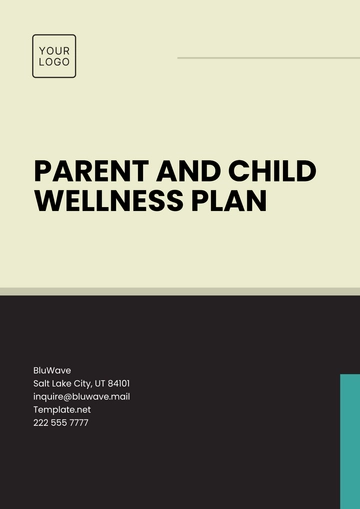Free Fitness and Exercise Wellness Plan

Prepared by: [Your Name]
Company: [Your Company Name]
Date: [Insert Date]
I. Introduction
Physical fitness and regular exercise are essential components of a healthy lifestyle. They not only improve physical health but also contribute to mental and emotional well-being, providing a holistic approach to overall wellness. This Fitness and Exercise Wellness Plan is designed to create a supportive environment that encourages individuals to engage in regular physical activity, improve their fitness levels, and adopt healthier habits.
The plan focuses on promoting long-term fitness by offering a variety of exercise options, providing the necessary resources and support, and fostering a culture that values physical activity.
II. Vision and Goals
Vision:
To inspire and support individuals in achieving their fitness goals, fostering a culture of health and well-being through regular exercise, and creating a sustainable approach to physical fitness that enhances overall quality of life.
Goals:
Encourage regular participation in physical exercise for improved physical health.
Provide a range of fitness options to cater to different preferences, fitness levels, and goals.
Promote the importance of physical fitness for mental clarity, stress management, and emotional well-being.
Foster a supportive fitness community that motivates and engages individuals to stay active.
III. Key Areas of Focus and Strategies
1. Fitness Programs
Strategies:
Diverse Exercise Classes: Offer a variety of fitness classes, such as yoga, Pilates, strength training, Zumba, and cycling, to cater to different interests and fitness levels.
Group Workouts: Organize weekly group fitness sessions that promote social interaction and accountability, such as running clubs, walking groups, or boot camps.
Personal Training: Provide access to personal trainers for one-on-one coaching and customized fitness plans.
Fitness Challenges: Organize fitness challenges (e.g., step challenges, weight loss competitions) to motivate individuals and foster a sense of community.
Virtual Fitness Options: Offer virtual classes or on-demand workout sessions to accommodate those with varying schedules or remote locations.
2. Physical Health Monitoring and Support
Strategies:
Health Screenings: Offer annual fitness assessments and health screenings, such as blood pressure checks, body mass index (BMI) measurements, and flexibility tests, to monitor progress and address potential health concerns.
Fitness Tracking Tools: Provide access to fitness-tracking devices or apps that allow individuals to monitor their activity, set goals, and track progress over time.
Exercise Education: Host workshops and seminars on the benefits of different types of exercise, injury prevention, and proper exercise techniques.
Nutrition Support: Provide resources for healthy eating habits that complement physical fitness, including nutrition workshops, healthy meal planning tips, and access to registered dietitians.
3. Mental Wellness and Exercise
Strategies:
Stress Relief Through Exercise: Encourage participation in exercise classes that focus on stress relief, such as yoga, Tai Chi, or meditation, to promote relaxation and mental clarity.
Mind-Body Connection: Promote the benefits of exercise on mental health, emphasizing its role in reducing anxiety, and depression, and improving mood.
Regular Mental Health Check-Ins: Offer opportunities for employees or participants to check in on their mental health status and seek support when necessary.
Mindfulness in Movement: Incorporate mindfulness practices in fitness routines, such as deep breathing exercises before or after workouts, to enhance mental relaxation.
4. Social Wellness Through Fitness
Strategies:
Social Fitness Events: Organize fitness events such as fun runs, charity walks, or team sports events that encourage socialization and community involvement.
Fitness Buddy System: Establish a buddy system that pairs individuals with fitness partners to support one another and stay motivated.
Inclusive Fitness Environment: Ensure that all fitness programs are accessible to individuals with varying fitness levels, physical abilities, and backgrounds, fostering an inclusive and supportive community.
Team Sports and Group Activities: Offer opportunities for employees or participants to engage in group sports like basketball, volleyball, or soccer to build teamwork and camaraderie.
5. Long-Term Sustainability and Fitness Habits
Strategies:
Habit Formation: Encourage participants to set realistic, achievable fitness goals and gradually increase the intensity and duration of their workouts.
Regular Goal-Setting: Provide tools for individuals to set short-term and long-term fitness goals and track their progress.
Fitness Incentives: Offer rewards and recognition for consistent participation in fitness activities, such as fitness milestones or meeting activity targets.
Education on Lifelong Fitness: Promote the importance of making fitness a lifelong habit, emphasizing the long-term health benefits, including enhanced mobility, reduced risk of chronic diseases, and improved quality of life.
IV. Implementation Plan
Roles and Responsibilities:
Wellness Committee: Oversee the planning, coordination, and evaluation of the fitness and exercise programs.
Fitness Instructors/Trainers: Lead fitness classes, personal training sessions, and group workouts, ensuring proper techniques and safety.
Participants: Actively engage in fitness programs, set personal fitness goals, and provide feedback on the wellness programs.
Leadership Team: Provide resources, funding, and support to implement and sustain the fitness initiatives.
Timeline:
Phase 1 (Month 1–3): Needs assessment and initial program planning. Introduce basic fitness offerings, health screenings, and group workouts.
Phase 2 (Month 4–6): Roll out additional fitness programs, such as group challenges, personal training sessions, and virtual fitness classes.
Phase 3 (Month 7–12): Evaluate the effectiveness of programs, refine strategies, and expand offerings based on feedback and participation rates.
V. Measurement and Evaluation
Key Performance Indicators (KPIs):
Participation Rates: Track the number of individuals engaging in fitness classes, group workouts, and fitness challenges.
Health and Fitness Metrics: Monitor improvements in fitness assessments, such as weight loss, strength gains, and flexibility.
Engagement and Satisfaction: Collect feedback through surveys or focus groups to gauge satisfaction with the programs and identify areas for improvement.
Retention Rates: Measure the long-term engagement of participants in fitness programs to assess the sustainability of fitness habits.
Evaluation Methods:
Quarterly surveys to assess participant satisfaction and gather feedback on program effectiveness.
Annual reviews of fitness program participation and health improvements.
Regular tracking of fitness goals and progress reports for individual participants.
VI. Sustainability Plan
Ongoing Funding: Secure funding through sponsorships, partnerships, or internal resources to continue offering fitness programs.
Adaptive Programs: Continuously adapt fitness offerings based on participant feedback, current fitness trends, and emerging health data.
Digital Integration: Implement digital tools and apps to track fitness progress, offer virtual workout options, and create a community platform for participants.
Leadership and Support: Ensure continued leadership involvement to advocate for fitness initiatives and provide necessary resources.
VII. Conclusion
This Fitness and Exercise Wellness Plan serves as a roadmap for fostering a culture of physical health and wellness within the community. By offering a variety of fitness programs, promoting mental well-being through exercise, and supporting long-term engagement in physical activity, this plan aims to improve the overall health and quality of life for all participants. Through consistent effort, support, and feedback, we will build a lasting commitment to fitness that contributes to a healthier, more balanced lifestyle.
- 100% Customizable, free editor
- Access 1 Million+ Templates, photo’s & graphics
- Download or share as a template
- Click and replace photos, graphics, text, backgrounds
- Resize, crop, AI write & more
- Access advanced editor
You may also like
- Finance Plan
- Construction Plan
- Sales Plan
- Development Plan
- Career Plan
- Budget Plan
- HR Plan
- Education Plan
- Transition Plan
- Work Plan
- Training Plan
- Communication Plan
- Operation Plan
- Health And Safety Plan
- Strategy Plan
- Professional Development Plan
- Advertising Plan
- Risk Management Plan
- Restaurant Plan
- School Plan
- Nursing Home Patient Care Plan
- Nursing Care Plan
- Plan Event
- Startup Plan
- Social Media Plan
- Staffing Plan
- Annual Plan
- Content Plan
- Payment Plan
- Implementation Plan
- Hotel Plan
- Workout Plan
- Accounting Plan
- Campaign Plan
- Essay Plan
- 30 60 90 Day Plan
- Research Plan
- Recruitment Plan
- 90 Day Plan
- Quarterly Plan
- Emergency Plan
- 5 Year Plan
- Gym Plan
- Personal Plan
- IT and Software Plan
- Treatment Plan
- Real Estate Plan
- Law Firm Plan
- Healthcare Plan
- Improvement Plan
- Media Plan
- 5 Year Business Plan
- Learning Plan
- Marketing Campaign Plan
- Travel Agency Plan
- Cleaning Services Plan
- Interior Design Plan
- Performance Plan
- PR Plan
- Birth Plan
- Life Plan
- SEO Plan
- Disaster Recovery Plan
- Continuity Plan
- Launch Plan
- Legal Plan
- Behavior Plan
- Performance Improvement Plan
- Salon Plan
- Security Plan
- Security Management Plan
- Employee Development Plan
- Quality Plan
- Service Improvement Plan
- Growth Plan
- Incident Response Plan
- Basketball Plan
- Emergency Action Plan
- Product Launch Plan
- Spa Plan
- Employee Training Plan
- Data Analysis Plan
- Employee Action Plan
- Territory Plan
- Audit Plan
- Classroom Plan
- Activity Plan
- Parenting Plan
- Care Plan
- Project Execution Plan
- Exercise Plan
- Internship Plan
- Software Development Plan
- Continuous Improvement Plan
- Leave Plan
- 90 Day Sales Plan
- Advertising Agency Plan
- Employee Transition Plan
- Smart Action Plan
- Workplace Safety Plan
- Behavior Change Plan
- Contingency Plan
- Continuity of Operations Plan
- Health Plan
- Quality Control Plan
- Self Plan
- Sports Development Plan
- Change Management Plan
- Ecommerce Plan
- Personal Financial Plan
- Process Improvement Plan
- 30-60-90 Day Sales Plan
- Crisis Management Plan
- Engagement Plan
- Execution Plan
- Pandemic Plan
- Quality Assurance Plan
- Service Continuity Plan
- Agile Project Plan
- Fundraising Plan
- Job Transition Plan
- Asset Maintenance Plan
- Maintenance Plan
- Software Test Plan
- Staff Training and Development Plan
- 3 Year Plan
- Brand Activation Plan
- Release Plan
- Resource Plan
- Risk Mitigation Plan
- Teacher Plan
- 30 60 90 Day Plan for New Manager
- Food Safety Plan
- Food Truck Plan
- Hiring Plan
- Quality Management Plan
- Wellness Plan
- Behavior Intervention Plan
- Bonus Plan
- Investment Plan
- Maternity Leave Plan
- Pandemic Response Plan
- Succession Planning
- Coaching Plan
- Configuration Management Plan
- Remote Work Plan
- Self Care Plan
- Teaching Plan
- 100-Day Plan
- HACCP Plan
- Student Plan
- Sustainability Plan
- 30 60 90 Day Plan for Interview
- Access Plan
- Site Specific Safety Plan





























